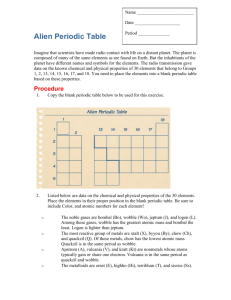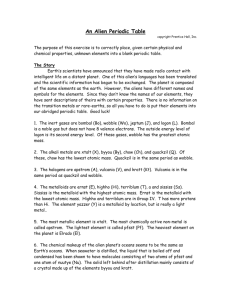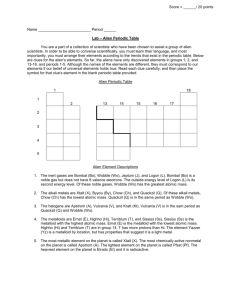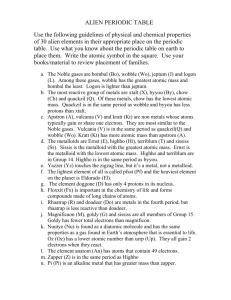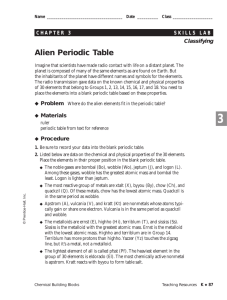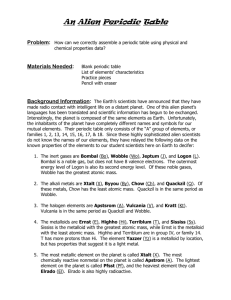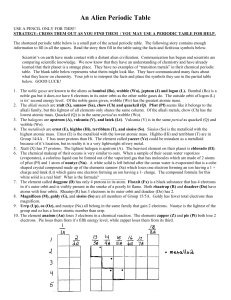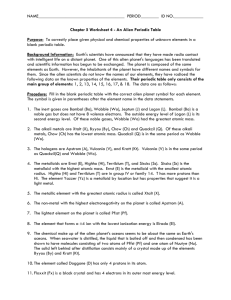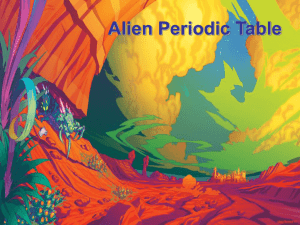Alien Periodic Table Lab
advertisement
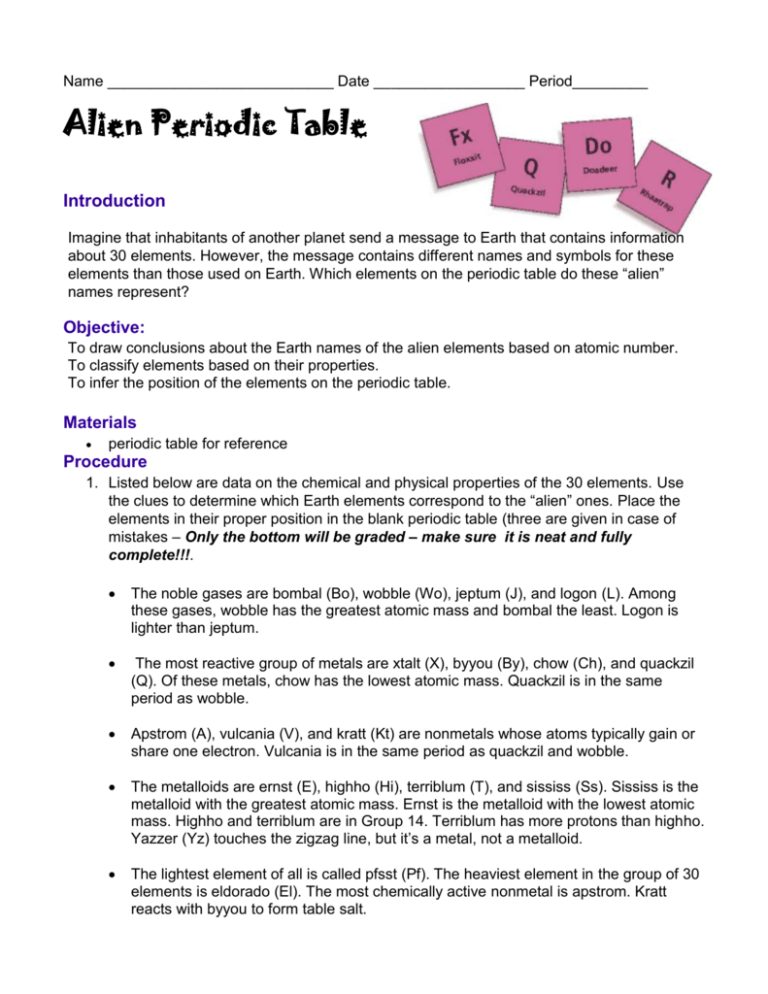
Name ___________________________ Date __________________ Period_________ Alien Periodic Table Introduction Imagine that inhabitants of another planet send a message to Earth that contains information about 30 elements. However, the message contains different names and symbols for these elements than those used on Earth. Which elements on the periodic table do these “alien” names represent? Objective: To draw conclusions about the Earth names of the alien elements based on atomic number. To classify elements based on their properties. To infer the position of the elements on the periodic table. Materials periodic table for reference Procedure 1. Listed below are data on the chemical and physical properties of the 30 elements. Use the clues to determine which Earth elements correspond to the “alien” ones. Place the elements in their proper position in the blank periodic table (three are given in case of mistakes – Only the bottom will be graded – make sure it is neat and fully complete!!!. The noble gases are bombal (Bo), wobble (Wo), jeptum (J), and logon (L). Among these gases, wobble has the greatest atomic mass and bombal the least. Logon is lighter than jeptum. The most reactive group of metals are xtalt (X), byyou (By), chow (Ch), and quackzil (Q). Of these metals, chow has the lowest atomic mass. Quackzil is in the same period as wobble. Apstrom (A), vulcania (V), and kratt (Kt) are nonmetals whose atoms typically gain or share one electron. Vulcania is in the same period as quackzil and wobble. The metalloids are ernst (E), highho (Hi), terriblum (T), and sississ (Ss). Sississ is the metalloid with the greatest atomic mass. Ernst is the metalloid with the lowest atomic mass. Highho and terriblum are in Group 14. Terriblum has more protons than highho. Yazzer (Yz) touches the zigzag line, but it’s a metal, not a metalloid. The lightest element of all is called pfsst (Pf). The heaviest element in the group of 30 elements is eldorado (El). The most chemically active nonmetal is apstrom. Kratt reacts with byyou to form table salt. The element doggone (D) has only 4 protons in its atoms. Floxxit (Fx) is important in the chemistry of life. It forms compounds made of long chains of atoms. Rhaatrap (R) and doadeer (Do) are metals in the fourth period, but rhaatrap is less reactive than doadeer. Magnificon (M), goldy (G), and sississ are all members of Group 15. Goldy has fewer total electrons than magnificon. Urrp (Up), oz (Oz), and nuutye (Nu) all gain 2 electrons when they react. Nuutye is found as a diatomic molecule and has the same properties as a gas found in Earth’s atmosphere. Oz has a lower atomic number than urrp. The element anatom (An) has atoms with a total of 49 electrons. Zapper (Z) and pie (Pi) lose two electrons when they react. Zapper is used to make lightweight alloys. 2. List the Alien names for the 30 Earth elements next to the corresponding Earth elements in the data table. Analysis 1. Were you able to place some elements within the periodic table with just a single clue? Explain using examples. _________________________________________________________________________ _________________________________________________________________________ _________________________________________________________________________ _________________________________________________________________________ 2. Why did you need two or more clues to place other elements? Explain using examples. _________________________________________________________________________ _________________________________________________________________________ _________________________________________________________________________ _________________________________________________________________________ 3. Why could you use clues about atomic mass to place elements, even though the table is now based on atomic numbers? _________________________________________________________________________ _________________________________________________________________________ _________________________________________________________________________ _________________________________________________________________________ 4. Which groups of elements are not included in the alien Periodic Table? _________________________________________________________________________ _________________________________________________________________________ _________________________________________________________________________ _________________________________________________________________________ Conclusion The conclusion section needs to have four sentences: 1st sentence: Repeat the purpose 2nd sentence: Tell how you achieved the purpose. 3rd sentence: Share what you learned. 4th sentence: This is a general summary of the lab. It ties into the first sentence of the purpose. ____________________________________________________________________________ ____________________________________________________________________________ ____________________________________________________________________________ ____________________________________________________________________________ ____________________________________________________________________________ ____________________________________________________________________________ ____________________________________________________________________________ ____________________________________________________________________________ ____________________________________________________________________________ ____________________________________________________________________________ ____________________________________________________________________________ ____________________________________________________________________________ ____________________________________________________________________________ ____________________________________________________________________________ ____________________________________________________________________________ ____________________________________________________________________________ ____________________________________________________________________________ ____________________________________________________________________________ ____________________________________________________________________________ ____________________________________________________________________________ ____________________________________________________________________________ ____________________________________________________________________________ ____________________________________________________________________________ Data Table Earth Element Hydrogen Helium Lithium Beryllium Boron Carbon Nitrogen Oxygen Fluorine Neon Sodium Magnesium Aluminum Silicon Phosphorus Sulfur Chlorine Argon Potassium Calcium Gallium Germanium Arsenic Selenium Bromine Krypton Rubidium Strontium Indium Tin Alien Element
